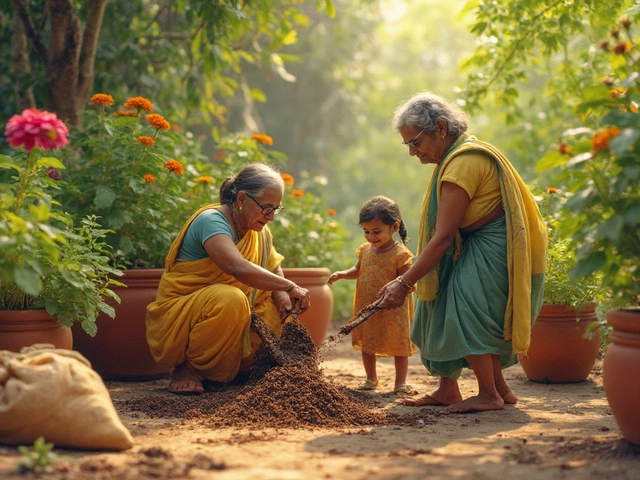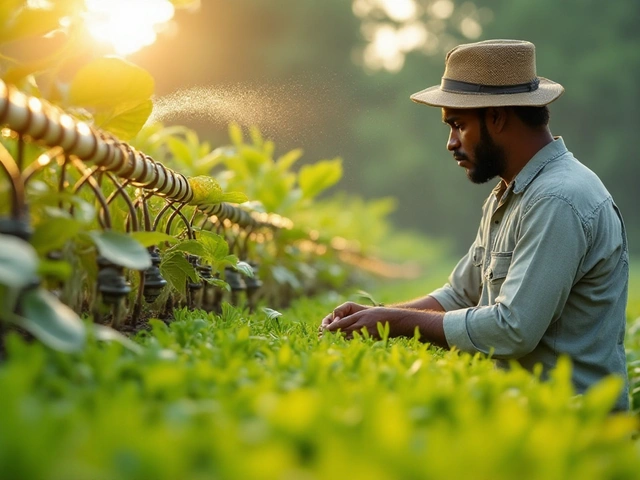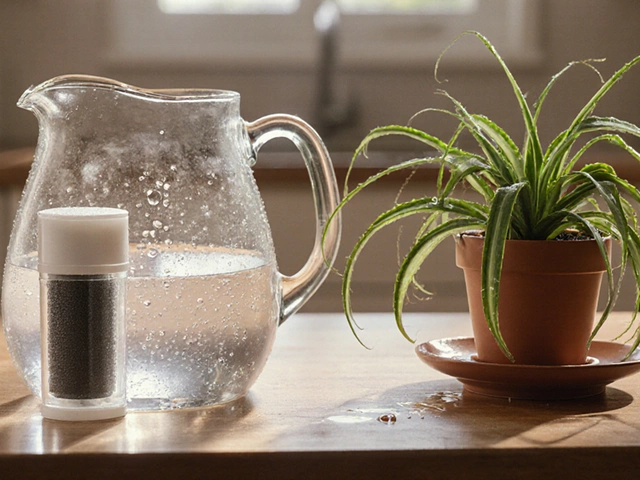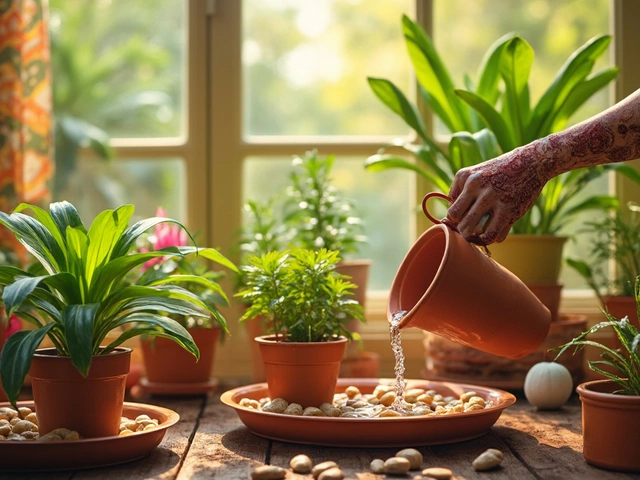Transforming your balcony into a lush haven filled with fruit can be both rewarding and practical. Imagine waking up to the scent of blossoming citrus or plucking fresh figs just outside your door. This isn’t just a dream; with the right know-how, it can be your reality. A balcony garden can seem intimidating at first, but with the proper selection of fruit trees, even the smallest spaces can become abundant in produce.
Choosing appropriate trees is crucial. Opt for dwarf varieties that thrive in pots and containers, making them perfect for balcony gardens. These tree types require less space while not compromising on yield. With the right amount of sunlight, care, and watering, your green corner of paradise will flourish, providing you not just with fruit, but with tranquility and a sense of accomplishment.
- Understanding Space and Requirements
- Best Fruit Trees for Balconies
- Caring for Dwarf Varieties
- Sunlight and Water Needs
- Balcony-Friendly Containers
- Common Challenges and Solutions
Understanding Space and Requirements
Before transforming that cozy balcony into a fruit-bearing haven, it's essential to comprehend the spatial limitations and requirements of a successful balcony garden setup. Whether you have an airy terrace or a snug slot outside your apartment, there are fruit trees suitable for every space. Proper planning involves not just imagining lush trees heavy with fruit, but understanding the growth patterns and climate needs of each potential candidate.
The first consideration is the space itself. Measure how much room you truly have. An average balcony can manage about 10 to 12 feet of length and 4 to 6 feet in depth. This space might seem modest, but it’s sufficient for several fruit trees if you go for compact, dwarf, or columnar varieties. These are specially cultivated to remain smaller, yet produce abundantly. Each tree should have enough room to expand without hinderance, ensuring healthy growth over time.
Equally important is the weight your balcony can safely hold. A well-established container tree can weigh upwards of 200 pounds or more when fully saturated with water. Often, apartments can manage about 40-50 pounds per square foot, which might limit the number you can accommodate. Consulting with a structural engineer or checking with your building’s management ensures you're not overburdening the space.
Water drainage is another critical factor in balcony gardening. Mystical as it sounds, fruit trees dislike having "wet feet." Without proper drainage in containers, the soil becomes saturated, roots can rot, and your cherished plants might perish. Ensure that each pot or container you use has sufficient drainage holes. Position saucers underneath to catch excess water, preventing discoloration or damage to your balcony floor.
“Good gardening involves knowing both the visible and latent requirements of your plants, ensuring a harmonious fit into each unique space,” notes the renowned horticulturist, Marcus Bridge.
Lastly, consider your own lifestyle. Frequent travelers may find automatic watering systems beneficial, while those who enjoy daily care can manually irrigate their potted plants. With these practical insights into balcony gardening space and requirements, you'll be on your way to nurturing a fruitful escape right at home.
Best Fruit Trees for Balconies
Gardening enthusiasts who live in urban environments often face the challenge of limited space. Yet, the dream of having a bountiful garden is within reach with the option of growing fruit trees right on the balcony. Given the right care and conditions, several tree varieties can thrive in pots and containers, bringing a touch of nature closer to city dwellers. So, which fruit trees should you consider?
The first contender for your balcony garden is the dwarf apple tree. Compact in size, dwarf apple varieties can often yield two kinds of apples on the same tree—a marvelous spectacle that also adds diversity to your produce. These trees typically start bearing fruit within a couple of years and are comparatively easy to maintain. Another excellent option is the Meyer lemon tree, favored for its sweet-flavored lemons and robust aroma. Originating in China, this tree is not only prolific but also adds a touch of Mediterranean elegance to any balcony.
For those who favor a richer taste, the fig tree could be your best bet. Dwarf varieties like 'Petite Negra' are known to fruit heavily while taking up minimal space. These trees are quite forgiving when it comes to soil quality, although they thrive best in a nutrient-rich environment. If space is at an extreme premium, consider strawberries. While not trees, they are excellent climbers in vertical gardens and can provide a juicy, delectable touch to your space. As sourced from a seasoned gardener in an article on UrbanHorticulture.org:
"The versatility and resilience of the fig tree make it a staple for anyone looking to cultivate in confined quarters."
Moving on to the stone fruit families, a dwarf peach tree can be a delightful addition. 'Bonanza' is a popular compact variety that blooms beautiful pink flowers before yielding small yet succulent peaches. Remember, peaches demand sunlight, so make sure your chosen spot receives an abundance. Lastly, consider the option of cherry trees. Specifically, the dwarf 'Stella' cherry has made a name for itself with its sweet-tasting fruit and modest stature, perfect for confined gardens.
By now, a balcony garden might seem like a viable project, and for good reason. To navigate this area wisely, consult your local garden center or a fruit-growing enthusiast to determine which trees are best suited for your climate. This will ensure your efforts blossom into a thriving oasis. A properly selected and cared-for balcony fruit tree can offer not just the bounty of fresh produce but also a serene escape into nature.

Caring for Dwarf Varieties
Growing dwarf varieties on your balcony is a fantastic way to bring the joy of gardening to those with limited space. Even though they are smaller, these trees require specific care to flourish and yield their exquisite bounty. Begin by selecting the appropriate pot—balcony-friendly containers should be about 15-20 gallons in size to allow enough room for root expansion. Remember, the pot must have proper drainage because stagnant water can lead to root rot, a common issue in container gardening. It's critical to use a potting mix that retains some moisture but also promotes drainage, usually containing components like perlite or vermiculite.
Of paramount importance is the location of your tree on the balcony. Dwarf varieties of fruit trees generally thrive in full sunlight, ideally six to eight hours daily. But they can also tolerate partial shade if direct sun exposure is limited. Engage in regular watering, especially during warmer months, as container soil can dry out quickly. However, avoid overwatering, which can drown the roots, hindering the tree's growth. Fertilize your dwarf fruit tree every four to six weeks during the growing season to keep it lush and productive. Opt for a balanced, slow-release fertilizer, ensuring that your balcony garden provides not just beauty, but an exciting palate of flavors throughout different seasons.
A critical part of caring for dwarf fruit trees is pruning, which helps maintain their size and encourages fruit production. The best time to prune most fruit trees is during the dormant season, particularly in late winter to early spring. Remove any dead or diseased wood, and thin out branches to allow sunlight to filter through the canopy, which is vital for blooming and fruit development. Consistently monitoring your tree for pests and diseases also ensures various little issues don't become big problems. Regularly inspect for aphids, scale, or spider mites, which can be managed with neem oil or insecticidal soap.
"Dwarf fruit trees are not just a smaller version of their counterparts; they're specially bred to provide maximum productivity, making them perfect for limited spaces," explains horticulturist Dr. Greenways.
Alterations in temperature can greatly impact the success of balcony-grown fruit trees. In regions with harsh winters or extremely hot summers, consider moving pots to a more sheltered area. If your balcony has high exposure to wind, creating a shield with trellises or a screen can safeguard your plants from potential damage. Also, using mulch can help to protect the roots from temperature variations and assist in moisture retention.
Ultimately, the dedication to caring for these beautiful trees on your balcony brings a rewarding payoff of fresh fruit and a delightful natural sanctuary to escape to from the comforts of your home. By nurturing these fruit trees on a balcony, you not only enhance your immediate environment but also engage in a sustainable practice that refreshes both body and soul.
Sunlight and Water Needs
When it comes to nurturing a thriving balcony garden, understanding the sunlight and water requirements of your fruit trees is crucial. Most fruit trees are sun-loving plants, craving at least six hours of direct sunlight per day. This love for the sun translates into the health and vigor of the plant, influencing everything from leaf growth to fruit production. Positioning your balcony garden in a south-facing direction can maximize exposure, but if that's not possible, selecting more shade-tolerant varieties could be an effective approach.
Watering, meanwhile, needs to be a regulated affair, as both over-watering and under-watering could lead to unhealthy plants. Typically, the soil should be kept moist but not soggy. A useful tip is to check the top inch of the soil; if it feels dry to the touch, it's time for a drink. Containers can dry out more quickly than ground soil, so they may require more frequent watering, especially during hot weather. For efficient water management, self-watering pots or adding mulch can help retain moisture.
Commenting on the synergy between sunlight and watering, Dr. Lisa Johnson, an expert in urban horticulture, states,
"Understanding the balance between light and water needs is as vital as the air we breathe. When your plants get this harmony right, they grow stronger and bear more fruit."This insight highlights the delicate interplay that nurtures successful balcony gardening. Efforts to monitor these conditions will go a long way in supporting your plants.
Here's a handy table for quick reference:
| Fruit Tree | Sunlight | Watering Frequency |
|---|---|---|
| Citrus | 6-8 Hours | Weekly |
| Apple | Full Sun | Moderate |
| Cherry | Partial to Full Sun | Twice a Week |
| Fig | 6-7 Hours | Once a Week |
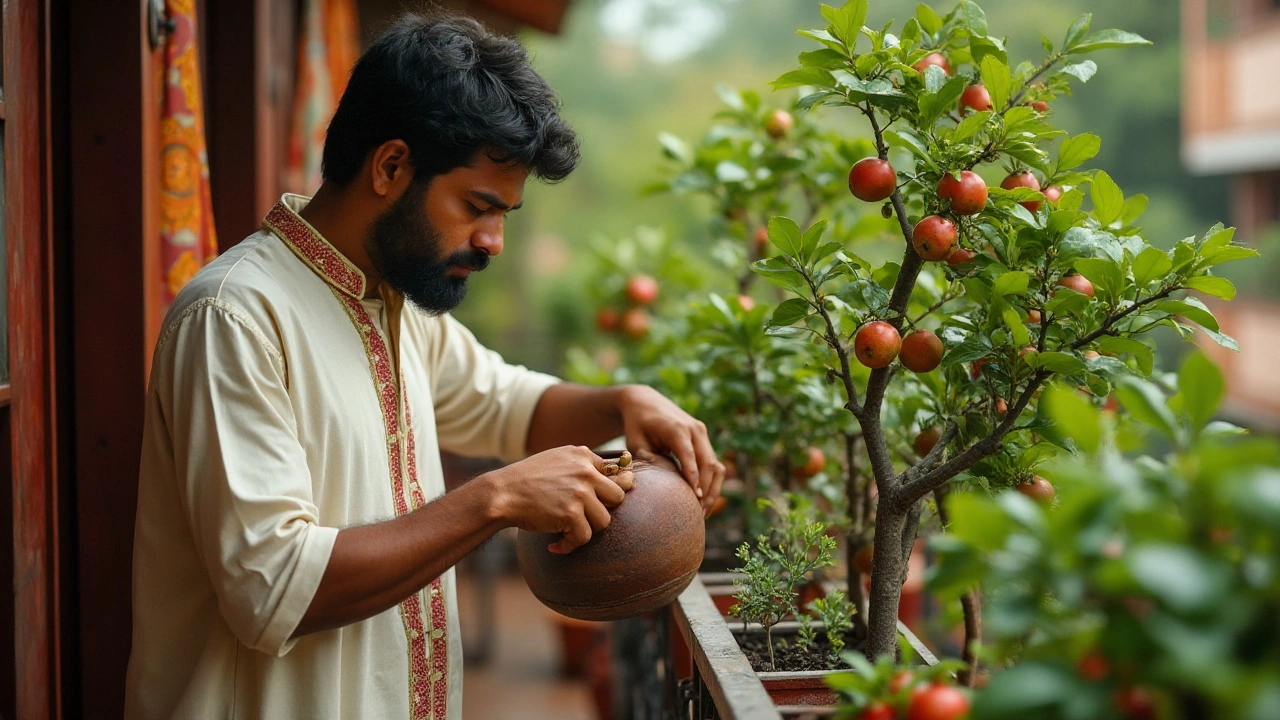
Balcony-Friendly Containers
Choosing the right containers is a pivotal part of nurturing a healthy balcony garden. Dwarf fruit trees, while compact in size, still require ample space for their roots to spread and grow. A container essentially acts as the tree’s home, influencing both its health and productivity. It's essential to select containers that allow for proper drainage to prevent waterlogging, a common issue that can lead to root rot. The material of the container, such as terracotta, plastic, or metal, affects both aesthetics and functionality. Each material has unique properties: terracotta offers breathability, plastic retains moisture, and metal can add an artistic touch while reflecting sunlight to keep soil warm during cooler months.
Exploring the size and shape is equally important. A container should be at least twice the size of the tree’s root ball. This not only promotes healthy root development but also ensures stability as your tree grows larger and bears fruit. When selecting balcony-friendly containers, ensure they are proportionate to the space you have available. Tall and narrow containers can be excellent for tight spots, while wide, robust pots are favorable where stability is essential. Style-wise, choosing uniform containers can create a seamless look, or mix different styles and colors for a unique and vibrant setting.
Innovative Self-Watering Options
For those who lead a busy lifestyle, self-watering containers can be a game-changer. These advanced designs store a reservoir of water at the base, allowing the plant to draw moisture as needed. This concept not only conserves water but also ensures consistent hydration for the fruit trees on your balcony, especially during hot summer months. According to a study by the Horticultural Society, self-watering containers increase plant vitality by up to 20% compared to traditional pots.
“Self-watering systems simplify the gardening process, especially for novice gardeners, ensuring that even in a short absence, the plants remain healthy,” notes Dr. Elaine Withers, a horticulture expert.
When setting up these systems, it's crucial to monitor the water levels and avoid overfilling. Too much water can negate the benefits by creating a waterlogged environment within the root zone. Regular checks ensure that your fruit trees balcony setup remains optimal and thriving.
Efficient Space Usage with Vertical Planters
In regions where balcony space is limited, vertical planters can create a dramatic impact. These allow multiple plants, including small fruit trees, to co-exist in an organized fashion, utilizing vertical space effectively. They can be mounted on walls, or freestanding units can be placed against balcony railings. Vertical options also come in various forms, from simple stacking pots to sophisticated hangable systems that integrate drip irrigation.
Regardless of the type, these planters improve the balcony’s appearance, giving it a green, lush aura while maximizing the growing area. This makes it possible to expand your range of plants beyond just traditional choices. Consider combining different textures and colors by pairing leafy greens with your fruit trees balcony to create an aesthetically pleasing environment that doubles as your fresh produce aisle.
Common Challenges and Solutions
Growing fruit trees on a balcony can come with its unique set of challenges, but with some thoughtful strategies, gardeners can overcome these hurdles. One of the primary obstacles tends to be limited space. Balconies aren't typically designed with gardening in mind, and the confinement can restrict root growth. To counteract this, choosing the right containers is essential. Opt for pots that offer ample space, ensuring good drainage and airflow to the roots. A larger pot not only supports robust growth but also prevents the issue of the tree becoming root-bound, which can hinder nutrient uptake.
Another frequent concern is the amount of sunlight balcony gardens receive. Many fruit trees need plenty of sun to thrive, typically around six to eight hours a day. However, balconies often face obstacles like nearby buildings that cast shadows, reducing available light. To mitigate this, proper positioning is key. If your balcony only gets partial light, consider choosing fruit varieties that are more shade-tolerant. Alternatively, using reflectors can help amplify available light. These mirrors or reflective surfaces can be strategically placed to bounce extra light toward your plants.
Water management on balconies can also pose a challenge, as excess water can lead to over-watering and drainage issues, which in turn cause root rot. Finding the balance in watering is crucial. Invest in pots with self-watering systems or use a saucer to catch excess water, allowing you to see how much your trees actually consume. Installing a moisture meter can further help ensure your plants don't sit in soggy soil, which can lead to fungal diseases. With this balance, your garden will maintain health and vitality without succumbing to common problems.
Pests and diseases are common in any garden, including in balcony setups, as pollinators, birds, and pests can all find their way to your green space. Implementing preventive care, like regular inspection and organic pest treatments, is indispensable. Companion planting is another technique that can help deter specific pests naturally. Introducing plants like marigolds and lavender can ward off some unwanted insects while simultaneously embellishing your balcony garden. As Benjamin Vogt once said,
"The garden is not a place. It's a journey." Embracing this journey with an attentive eye and proactive strategies will help you navigate these common hurdles more effectively.
Lastly, the issue of seasonal changes can impact how well your fruit trees on a balcony cope throughout the year. Cold snaps and heatwaves can both stress plants used to consistent climates. Employing winter protection, like mulching and insulating wraps, can help guard against frost. During hotter months, shade cloths can shield your fruit trees from scorching sun exposure. Additionally, choose varieties that fit your climate zone, which can offer some resilience against temperature fluctuations. Understanding these seasonal patterns allows you to adapt your care routine and keep your balcony garden thriving through each phase of the year.


